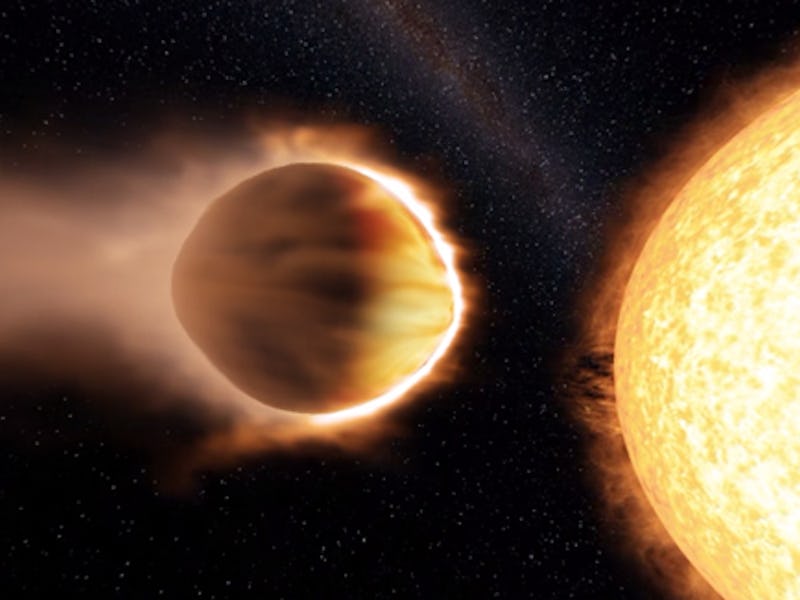Exoplanet's Atmosphere Is So Hot That It's Boiling Away Into Space
Its host star's gravity is warping WASP-121b into the shape of a rugby ball.

The atmosphere of an exoplanet about 900 light years from Earth is so hot that its surface metals are vaporizing and escaping the planet’s gravitational pull. As if that wasn’t enough, the intense gravity of the planet’s host star has also deformed the sizzling planet into a rugby ball shape.
Scientists had previously found that WASP-121b had an extrasolar planetary stratosphere, an atmospheric layer in which temperatures increase as the altitude increases, indicating water molecules are present. But these most recent discoveries, made possible by NASA’s Hubble Space Telescope, are new and were published in the August 2019 issue of The Astronomical Journal.
“The escape of atoms like iron and magnesium, and the filling of the Roche lobe shape were not previously known and are independent of the water emission that also occurs,” L. Drake Deming, co-author of the new paper and a professor of astronomy at the University of Maryland, told Inverse.
“The water emission comes from deeper layers of the planet’s atmosphere than do the escaping iron and magnesium,” he says. “However, all of those phenomena are related to the large deposition of stellar radiative energy in the planet’s atmosphere, i.e. it’s all ultimately driven by the host star.”
The new observations, made by an international team of astronomers using the Hubble Telescope, describe the first known instance of heavy metal gas streaming away from a “hot Jupiter,” a nickname for large, gaseous exoplanets that orbit very close to their host stars.
Its mass is 1.2 times that of Jupiter, and its radius is about 1.9 times Jupiter’s, but while Jupiter revolves around our sun once every 12 years, WASP-121b has an orbital period of just 1.3 days. This exoplanet is so close to its host star that if it got any closer, the star’s gravity would rip it apart. It also means that the top of the planet’s atmosphere is heated to a blazing 4,600ºF (2,500ºC), hot enough to boil some metals.
“Heavy metals have been seen in other hot Jupiters before, but only in the lower atmosphere,” lead researcher David Sing of Johns Hopkins University said in a statement. “With WASP-121b, we see magnesium and iron gas so far away from the planet that they’re not gravitationally bound. The heavy metals are escaping partly because the planet is so big and puffy that its gravity is relatively weak. This is a planet being actively stripped of its atmosphere.”
The constellation Puppis, visible in the southern hemisphere, looking north.
“For sure there are other planets like this, for example KELT-9b is even more extreme,” Deming says. “I think the implications are stronger for planetary evolution than formation per se. These planets are losing mass — essentially evaporating.
“If their orbit is not unstable — some will spiral into their stars — then they will eventually leave behind a rocky/metallic core as their gaseous envelope escapes to space,” he says. “It’s possible that some of the ‘hot super-Earths’ that have been detected close to their host stars are actually remnant cores of evaporated ultra-hot Jupiters.”
The host star, WASP-121, is a magnitude 10.4 star located in the constellation Puppis and has a mass and radius similar to the sun.
Observations from the Webb telescope should give astronomers a better idea of the chemical elements that make up the atmospheres of exoplanets
According to the researchers, WASP-121b will be an ideal target for NASA’s James Webb Space Telescope, scheduled for launch in 2021. The Webb telescope will allow researchers to search for water and carbon dioxide, which can be detected at longer, redder wavelengths of infrared light.
“The more we study exoplanets, the more variety we find, and this is a great example of an extreme,” planetary scientist Dr. Bruce Betts, who was not involved in the research, told Inverse.
“Until the last 25 years, we had only one set of planets to study, our own solar system,” says Betts. “Now that we are finding and studying the incredible variety of exoplanets, we are learning much more not only about those exoplanets, but also about the complexities of planetary formation.”